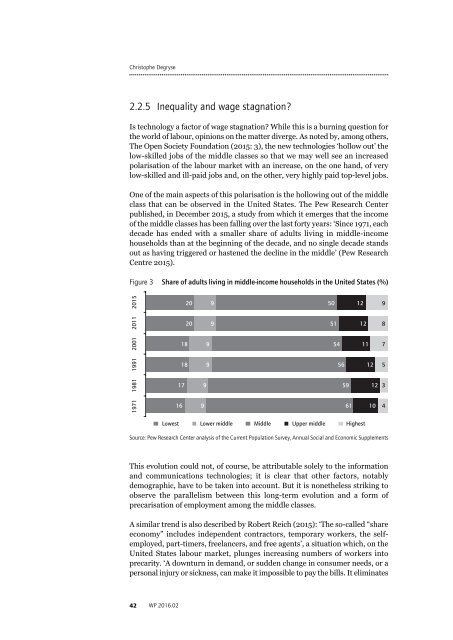Digitalisation of the economy and its impact on labour markets —
ver+2+web+version+Working+Paper+2016+02-EN+digitalisation
ver+2+web+version+Working+Paper+2016+02-EN+digitalisation
Create successful ePaper yourself
Turn your PDF publications into a flip-book with our unique Google optimized e-Paper software.
Christophe Degryse<br />
2.2.5 Inequality <str<strong>on</strong>g>and</str<strong>on</strong>g> wage stagnati<strong>on</strong>?<br />
Is technology a factor <str<strong>on</strong>g>of</str<strong>on</strong>g> wage stagnati<strong>on</strong>? While this is a burning questi<strong>on</strong> for<br />
<str<strong>on</strong>g>the</str<strong>on</strong>g> world <str<strong>on</strong>g>of</str<strong>on</strong>g> <strong>labour</strong>, opini<strong>on</strong>s <strong>on</strong> <str<strong>on</strong>g>the</str<strong>on</strong>g> matter diverge. As noted by, am<strong>on</strong>g o<str<strong>on</strong>g>the</str<strong>on</strong>g>rs,<br />
The Open Society Foundati<strong>on</strong> (2015: 3), <str<strong>on</strong>g>the</str<strong>on</strong>g> new technologies ‘hollow out’ <str<strong>on</strong>g>the</str<strong>on</strong>g><br />
low-skilled jobs <str<strong>on</strong>g>of</str<strong>on</strong>g> <str<strong>on</strong>g>the</str<strong>on</strong>g> middle classes so that we may well see an increased<br />
polarisati<strong>on</strong> <str<strong>on</strong>g>of</str<strong>on</strong>g> <str<strong>on</strong>g>the</str<strong>on</strong>g> <strong>labour</strong> market with an increase, <strong>on</strong> <str<strong>on</strong>g>the</str<strong>on</strong>g> <strong>on</strong>e h<str<strong>on</strong>g>and</str<strong>on</strong>g>, <str<strong>on</strong>g>of</str<strong>on</strong>g> very<br />
low-skilled <str<strong>on</strong>g>and</str<strong>on</strong>g> ill-paid jobs <str<strong>on</strong>g>and</str<strong>on</strong>g>, <strong>on</strong> <str<strong>on</strong>g>the</str<strong>on</strong>g> o<str<strong>on</strong>g>the</str<strong>on</strong>g>r, very highly paid top-level jobs.<br />
One <str<strong>on</strong>g>of</str<strong>on</strong>g> <str<strong>on</strong>g>the</str<strong>on</strong>g> main aspects <str<strong>on</strong>g>of</str<strong>on</strong>g> this polarisati<strong>on</strong> is <str<strong>on</strong>g>the</str<strong>on</strong>g> hollowing out <str<strong>on</strong>g>of</str<strong>on</strong>g> <str<strong>on</strong>g>the</str<strong>on</strong>g> middle<br />
class that can be observed in <str<strong>on</strong>g>the</str<strong>on</strong>g> United States. The Pew Research Center<br />
published, in December 2015, a study from which it emerges that <str<strong>on</strong>g>the</str<strong>on</strong>g> income<br />
<str<strong>on</strong>g>of</str<strong>on</strong>g> <str<strong>on</strong>g>the</str<strong>on</strong>g> middle classes has been falling over <str<strong>on</strong>g>the</str<strong>on</strong>g> last forty years: ‘Since 1971, each<br />
decade has ended with a smaller share <str<strong>on</strong>g>of</str<strong>on</strong>g> adults living in middle-income<br />
households than at <str<strong>on</strong>g>the</str<strong>on</strong>g> beginning <str<strong>on</strong>g>of</str<strong>on</strong>g> <str<strong>on</strong>g>the</str<strong>on</strong>g> decade, <str<strong>on</strong>g>and</str<strong>on</strong>g> no single decade st<str<strong>on</strong>g>and</str<strong>on</strong>g>s<br />
out as having triggered or hastened <str<strong>on</strong>g>the</str<strong>on</strong>g> decline in <str<strong>on</strong>g>the</str<strong>on</strong>g> middle’ (Pew Research<br />
Centre 2015).<br />
Figure 3 Share <str<strong>on</strong>g>of</str<strong>on</strong>g> adults living in middle-income households in <str<strong>on</strong>g>the</str<strong>on</strong>g> United States (%)<br />
2015<br />
20<br />
9<br />
50<br />
12<br />
9<br />
2011<br />
20<br />
9<br />
51<br />
12<br />
8<br />
2001<br />
18<br />
9<br />
54<br />
11<br />
7<br />
1991<br />
18<br />
9<br />
56<br />
12<br />
5<br />
1981<br />
17<br />
9<br />
59<br />
12<br />
3<br />
1971<br />
16<br />
9<br />
61<br />
10<br />
4<br />
Lowest Lower middle Middle Upper middle Highest<br />
Source: Pew Research Center analysis <str<strong>on</strong>g>of</str<strong>on</strong>g> <str<strong>on</strong>g>the</str<strong>on</strong>g> Current Populati<strong>on</strong> Survey, Annual Social <str<strong>on</strong>g>and</str<strong>on</strong>g> Ec<strong>on</strong>omic Supplements<br />
This evoluti<strong>on</strong> could not, <str<strong>on</strong>g>of</str<strong>on</strong>g> course, be attributable solely to <str<strong>on</strong>g>the</str<strong>on</strong>g> informati<strong>on</strong><br />
<str<strong>on</strong>g>and</str<strong>on</strong>g> communicati<strong>on</strong>s technologies; it is clear that o<str<strong>on</strong>g>the</str<strong>on</strong>g>r factors, notably<br />
demographic, have to be taken into account. But it is n<strong>on</strong>e<str<strong>on</strong>g>the</str<strong>on</strong>g>less striking to<br />
observe <str<strong>on</strong>g>the</str<strong>on</strong>g> parallelism between this l<strong>on</strong>g-term evoluti<strong>on</strong> <str<strong>on</strong>g>and</str<strong>on</strong>g> a form <str<strong>on</strong>g>of</str<strong>on</strong>g><br />
precarisati<strong>on</strong> <str<strong>on</strong>g>of</str<strong>on</strong>g> employment am<strong>on</strong>g <str<strong>on</strong>g>the</str<strong>on</strong>g> middle classes.<br />
A similar trend is also described by Robert Reich (2015): ‘The so-called “share<br />
<str<strong>on</strong>g>ec<strong>on</strong>omy</str<strong>on</strong>g>” includes independent c<strong>on</strong>tractors, temporary workers, <str<strong>on</strong>g>the</str<strong>on</strong>g> selfemployed,<br />
part-timers, freelancers, <str<strong>on</strong>g>and</str<strong>on</strong>g> free agents’, a situati<strong>on</strong> which, <strong>on</strong> <str<strong>on</strong>g>the</str<strong>on</strong>g><br />
United States <strong>labour</strong> market, plunges increasing numbers <str<strong>on</strong>g>of</str<strong>on</strong>g> workers into<br />
precarity. ‘A downturn in dem<str<strong>on</strong>g>and</str<strong>on</strong>g>, or sudden change in c<strong>on</strong>sumer needs, or a<br />
pers<strong>on</strong>al injury or sickness, can make it impossible to pay <str<strong>on</strong>g>the</str<strong>on</strong>g> bills. It eliminates<br />
42 WP 2016.02


